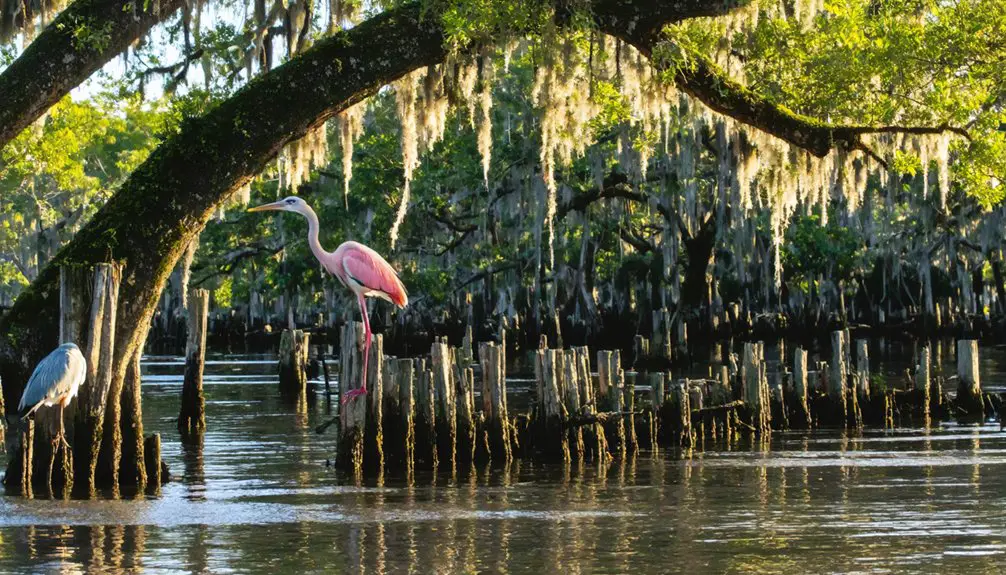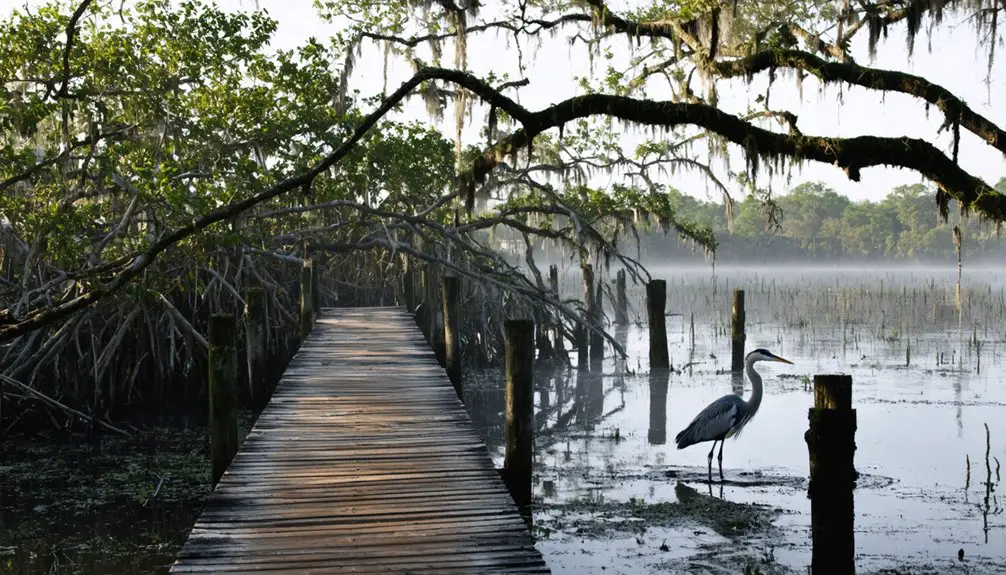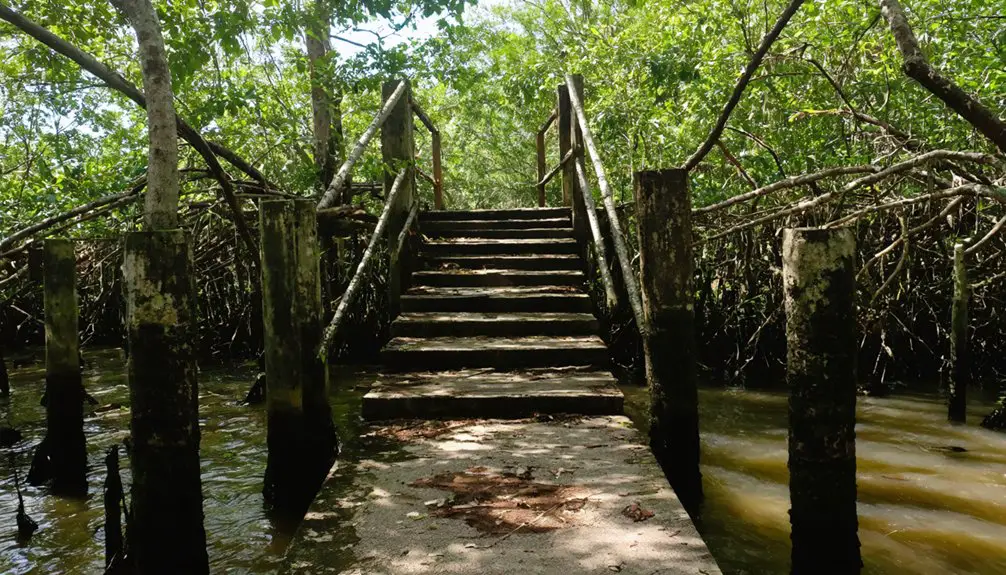You’ll discover the fascinating remnants of Weedon Island’s bootlegging past along Tampa Bay’s mangrove-lined shores. This historic site first gained notoriety during Prohibition as a haven for speakeasies and rum runners, though its history stretches back thousands of years to indigenous settlements. Today, the former bootlegger’s paradise has transformed into a peaceful 3,700-acre nature preserve where ancient shell mounds and hidden waterways hold centuries of untold stories.
Key Takeaways
- Weedon Island transformed from an indigenous settlement to an abandoned bootlegging hub after Prohibition’s end in the 1930s.
- The area’s development as “the Riviera of the South” failed, leaving behind remnants of speakeasies and abandoned structures.
- Archaeological remains, including shell mounds and burial grounds, are the primary remnants of the once-thriving Tocobaga civilization.
- The Ross family’s historic homestead and Grand Central Airport structures were largely abandoned, contributing to the ghost town atmosphere.
- Ancient dugout canoes, pottery, and ceremonial artifacts mark the site of vanished communities spanning over 7,000 years.
The Early Settlement and Indigenous Origins
While modern visitors might know Weedon Island as a ghost town, its rich history stretches back to around 5000 BCE when indigenous peoples first settled the area.
You’ll find evidence of their sophisticated culture in the stone tools, shell middens, and distinctive pottery styles they left behind. These ancient inhabitants mastered maritime skills, crafting 40-foot dugout canoes for open water navigation. The Smithsonian archeologists excavated remarkable Weedon Island pottery artifacts during their 1920s expeditions.
Their settlement patterns reveal a deep connection to the land, with indigenous practices centered around the region’s abundant natural resources. They built ceremonial mounds aligned with astronomical events and created both everyday and ornate pottery. The Tocobaga people were among these early inhabitants who thrived in the area for thousands of years.
When Euro-American settlers arrived in 1842, they encountered an area shaped by millennia of human presence, including the Ross family in 1866 and the Weedon family in 1898.
Archaeological Discoveries and Cultural Heritage
You’ll find remarkable evidence of ancient life in the massive shell mounds discovered at Weedon Island, where Indigenous peoples crafted tools and hammers from discarded shells over 4,000 years ago.
Among the most significant cultural findings is a ceremonial cup used in the sacred Black Drink ritual, where participants consumed a highly caffeinated tea to achieve spiritual visions and purification.
These archaeological treasures reveal the deep spiritual connection between Weedon Island’s early inhabitants and their environment, preserving their ceremonial practices through carefully excavated artifacts. Modern preservation efforts led by Duke Energy’s remediation project continue to uncover important historical artifacts from the site. The site’s rich history includes early Smithsonian excavations in the 1920s that unearthed numerous burial mounds and skeletal remains.
Ancient Shell Mound Discoveries
The ancient shell mounds at Weedon Island stand as remarkable monuments to over 4,000 years of indigenous habitation and cultural practices.
When you explore these massive middens, you’ll find evidence of sustained shellfish gathering, with layers primarily composed of oyster and other seafood remains. Through careful stratigraphic analysis, archaeologists have uncovered a treasure trove of artifacts, including shell tools and pottery, that reveal the rich cultural heritage of the site’s original inhabitants. The Smithsonian Institution conducted groundbreaking excavations of these mounds in the 1920s.
These mounds aren’t just trash heaps – they’re time capsules that tell the story of a sophisticated society. Archaeologists have identified distinct sacred and secular ceramics within these sites, with the more elaborate ritual pottery found in ceremonial contexts.
You can see how these ancient people crafted tools from large shells, developed intricate pottery designs, and maintained a thriving community that balanced both ceremonial and everyday activities along Florida’s coast.
Sacred Black Drink Rituals
Among the most fascinating discoveries at Weedon Island, sacred vessels and artifacts reveal an ancient ceremonial tradition centered around the Black Drink ritual.
You’ll find evidence of these purification rituals in shell vessels and decorated pottery, often adorned with bird motifs that symbolize spiritual connections to other dimensions.
The Black Drink itself, brewed from yaupon holly berries, played a significant role in indigenous heritage and shamanistic traditions. The powerful substance was known to induce vomiting and hallucinations during sacred ceremonies.
When you examine the archaeological record, you’ll notice these ceremonial practices were deeply woven into the social fabric, with ritual significance extending beyond Weedon Island through cultural exchange networks. Historical evidence shows these indigenous communities were actively involved in trade networks that spread ritual items to distant regions.
The discovery of vessels in sacred contexts, particularly near burial grounds and ceremonial mounds, demonstrates how these practices helped maintain spiritual connections between the physical and spirit worlds for thousands of years.
The Rise and Fall of a Bootlegger’s Paradise
During Prohibition’s iron grip on America, Weedon Island transformed into a notorious haven for bootleggers seeking to exploit its strategic location along Tampa Bay.
Nestled along Tampa Bay, Weedon Island became a bootlegger’s sanctuary during America’s dry years, its shores whispering tales of contraband.
You’d find secluded speakeasies hidden across the island, while gunfire regularly echoed through the night as rival smugglers fought for control of lucrative rum-running routes.
The island’s bootlegging operations reached their peak when Grand Central Airport opened in the 1930s, providing another avenue for clandestine shipments. Today, visitors can explore the area’s history through clips and carousels shared by local historians.
Despite a developer’s attempts to rebrand the island as “the Riviera of the South,” the constant violence and illegal activities kept legitimate tourism at bay. The land had previously belonged to Dr. Leslie Weedon, who originally envisioned it as an idyllic weekend retreat.
Even after archaeological discoveries revealed ancient artifacts and a thousand-year-old dugout canoe, Weedon Island’s reputation as a “bootlegger’s paradise” persisted until changing laws finally ended the era.
From Private Estate to Public Preserve
While many visitors today know Weedon Island as a protected nature preserve, its journey from private homestead to public land spans over 180 years of changing ownership and competing visions.
The private ownership saga began in 1842 with a homestead claim, followed by the Ross family settling there in 1866. The estate shift took a significant turn when Captain Henderson acquired the land and gifted it to his daughter Blanche upon her marriage to Dr. Leslie Weedon in 1898.
You’ll find the most dramatic changes came after the Weedons sold in 1923. The land faced neglect until 1974, when the state purchased it using Endangered Lands Acquisition Act funds.
Despite threats of closure and development proposals, public pressure guaranteed the island’s preservation as the natural treasure you can explore today.
Natural Wonders and Ecological Significance

When you explore Weedon Island’s vast mangrove forests, you’ll find essential nursery habitats that shelter young fish, crabs, and countless marine species in their intricate root systems.
The preserve’s pine flatwoods create distinct wildlife communities where deer, rabbits, and diverse bird species thrive among the saw palmetto understory.
Your journey through these ecosystems reveals the dynamic interplay between tidal waters and coastal landscapes, where twice-daily water movements shape the environment and sustain the rich biodiversity of the area.
Coastal Mangrove Nursery Habitats
Among Florida’s most remarkable coastal ecosystems, the mangrove forests of Weedon Island Preserve serve as essential nursery grounds for marine life.
You’ll find three distinct mangrove species here, with the red mangrove‘s distinctive “prop roots” creating intricate underwater shelters. These natural nursery habitats protect young fish, crabs, and shellfish during their vulnerable early stages.
The mangrove importance extends beyond protection – their fallen leaves nourish the waters, sustaining the food web that supports both juvenile and adult marine species.
An impressive 75% of Florida’s game fish and 90% of commercial species depend on these habitats during some part of their life cycle.
The complex root systems you’ll discover while exploring create a labyrinth of life, where countless marine creatures find refuge and sustenance.
Pine Flatwood Wildlife Communities
The majestic pine flatwoods of Weedon Island stand as Florida’s most extensive terrestrial ecosystem, historically covering half the state’s landscape.
You’ll discover remarkable pine flatwood biodiversity within these grounds, where South Florida slash pines create an open canopy above a diverse understory of saw palmetto, gallberry, and wildflowers.
As you explore, you’ll encounter wildlife adaptations that showcase nature’s resilience. The layered habitat supports endangered Florida panthers, protected Key deer, and countless birds that rely on these grounds for survival.
Seasonal changes in moisture, from drought to flooding, have shaped unique communities where amphibians thrive in wet areas while reptiles bask in drier zones.
Despite habitat fragmentation threatening these ecosystems, restoration efforts through prescribed burns help maintain this essential wilderness for future generations.
Tidal Ecosystem Dynamics
Standing as dynamic guardians of coastal resilience, Weedon Island’s tidal ecosystems showcase remarkable geomorphological features that shape the preserve’s ecological identity.
You’ll find shell middens and sand mounds rising 6 to 26 feet above sea level, creating natural barriers that protect estuarine connectivity and influence tidal flow patterns.
As climate impacts intensify, you’re witnessing dramatic shifts in habitat heterogeneity.
Mangrove encroachment is transforming traditional oyster reef territories, while habitat restoration efforts focus on removing artificial barriers to revive natural sediment dynamics.
The preserve’s ecological resilience depends on maintaining critical tidal channels and salt marshes that support diverse wildlife communities.
Through strategic coastal geomorphology management, Weedon Island adapts to sea-level rise while preserving its essential role in Tampa Bay’s environmental heritage.
Hidden Treasures of Tampa Bay

Deep beneath Tampa Bay’s tranquil waters and buried within its coastal landscapes lie countless archaeological treasures that tell the story of ancient maritime cultures.
You’ll discover evidence of sophisticated maritime navigation spanning over 12,000 years, including the remarkable 40-foot dugout canoe – the longest prehistoric vessel found in Eastern North America. This hidden artifact, preserved in mud for a millennium, reveals the extraordinary seafaring skills of Tampa Bay’s indigenous peoples.
At Weedon Island, you can explore shell middens, burial mounds, and thousands of artifacts that showcase the rich heritage of early coastal societies.
The Smithsonian’s excavations in the 1920s unearthed hundreds of burials and tools, proving that these waters have long been a hub of human innovation and cultural development.
Legacy of the Lost Island Community
Once a bustling settlement with indigenous roots stretching back thousands of years, Weedon Island‘s community legacy spans from ancient shell mound builders to early European settlers like Lorenzo and Inez Ross.
You’ll find traces of this lost island community in the archaeological remnants of the Weeden Island Culture, where ceremonial black drink cups and shell hammers tell stories of complex indigenous life.
The island’s character transformed through the ages, from the Ross family’s pioneering homestead to Dr. Leslie Weedon’s weekend retreat.
In the 1920s and ’30s, you could’ve encountered bootleggers at the local speakeasy or stumbled upon a movie studio.
Though the ghost town never developed permanent infrastructure, its rich cultural tapestry endures through ongoing archaeological discoveries and preservation efforts.
Frequently Asked Questions
Are There Any Remaining Structures From the 1930S Movie Studio?
Based on remnants analysis and studio history, you won’t find any surviving structures from the 1930s movie studio – the buildings were either demolished or decayed completely after the operation’s quick closure.
What Happened to Leslie Weedon’s Weekend Home Built on the Shell Mound?
You won’t find Leslie Weedon’s original wooden weekend home today – it disappeared from the shell mound, likely succumbing to deterioration or being removed during later development efforts after his 1923 sale.
Can Visitors Access the Ross Family Graves on the Island Today?
You can visit the Ross family graves near the preserve’s entrance during park hours. These historically significant burial sites of early settlers are accessible along established paths within Weedon Island Preserve.
Were Any Prohibition-Era Artifacts Recovered From the Speakeasy Location?
You won’t find documented prohibition artifacts from the speakeasy location, as archaeological reports haven’t published specific finds. While the speakeasy history is known, excavations focused mainly on Native American remains.
How Did Captain Henderson Acquire the War Bonds to Purchase Weedon Island?
Like eagles earning their wings, you’ll find Captain Henderson acquired his war bonds through military service, though specific details of his rank, conflicts, and compensation strategy remain historically uncertain.
References
- https://en.wikipedia.org/wiki/Weedon_Island
- https://illumination.duke-energy.com/articles/discoveries-on-weedon-island-tell-the-story-of-the-ancients
- https://wanderflorida.net/weedon-island-preserve/
- https://en.wikipedia.org/wiki/Weedon_Island_Preserve
- https://www.youtube.com/watch?v=AviQc2TIuF4
- https://baysoundings.com/treasures-of-tampa-bay-weedon-island/
- https://www.fox13news.com/news/weedon-islands-prehistoric-past-gives-glimpse-into-bay-areas-native-american-culture
- https://en.wikipedia.org/wiki/Weeden_Island_culture
- https://www.stpetersburg.usf.edu/news/2022/archaeology-weedon-island-students-excavation.aspx
- https://www.youtube.com/watch?v=e8WHjGybHKQ



